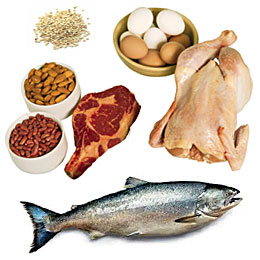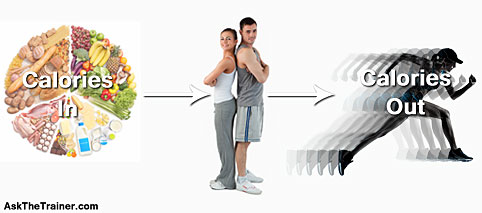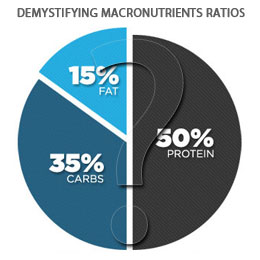- Like
- SHARE
- Digg
- Del
- Tumblr
- VKontakte
- Flattr
- Buffer
- Love This
- Save
- Odnoklassniki
- Meneame
- Blogger
- Amazon
- Yahoo Mail
- Gmail
- AOL
- Newsvine
- HackerNews
- Evernote
- MySpace
- Mail.ru
- Viadeo
- Line
- Comments
- Yummly
- SMS
- Viber
- Telegram
- JOIN
- Skype
- Facebook Messenger
- Kakao
- LiveJournal
- Yammer
- Edgar
- Fintel
- Mix
- Instapaper
- Copy Link
 Way Beyond Calorie Counting: Utilizing Macros Helps Accelerate Fat Loss and Muscle Gain
Way Beyond Calorie Counting: Utilizing Macros Helps Accelerate Fat Loss and Muscle Gain
There are a lot of goofy (and yes, not so goofy) dieting ideas out there. Some are super restrictive and others just overly complicated. So let’s talk about a super-effective and flexible way of approaching fitness nutrition: custom MACRONUTRIENT RATIOS. Many diet plans out there, such as ketogenic diets, the Zone, etc., use the concept of macronutrient ratios. Bodybuilders and physique competitors have been deeply into custom macros since time immemorial. Time for the rest of us to get wise and take our eating choices into our own hands to finally see the progress we are after.
Even though the average person’s macro plan won’t look like a bodybuilder’s, anyone with access to the internet, a calculator, and a third grade math education can harness the power of this eating system. Smart utilization of a macro eating plan is one of the best ways to accelerate your progress toward your unique goals, whether you are looking to shed extra fat, pack on pounds of lean muscle, or improve your strength, endurance, and power performance. When you do reach your goals, keeping up with your macros ensures that you maintain what you have achieved instead of letting your progress fall by the wayside while you’re wondering what went wrong.
How Nutrition Ties into Your Fitness Goals
Whether you’re seeking to lose pounds of fat or boost your lean muscle mass, you’ll have to agree that nutrition is one of the most important tools you have at your disposal. A well-designed exercise routine and a well-thought out nutrition plan rank neck-and-neck in importance when discussing any kind of fat loss or muscle gain goals. Maybe you’ve heard the saying, “you can’t out-train a bad diet”. Absolutely true! You may certainly make some progress if you’re exercising like a BEAST and eating like a starving dog at every meal, but you’re shooting yourself in the foot and slowing your progress to a crawl when you could be galloping toward your goals. A lot of animal metaphors in there, I know.
So What are Macros?
OK, I’ll get off my soapbox and get to the nitty-gritty. “Macros” is shorthand for “macronutrients”, of which there are three types: carbohydrates, protein, and fat. Each of the three macros can be thought of in terms of its calorie density. Carbohydrates and protein both have 4 calories per gram, while fats have 9 calories per gram. Each of these nutrients comes for different sources and goes on to play essential roles in our body function, summarized below:
Carbohydrates

What Are They and Why Do I Need ‘Em?
Carbohydrates come in many “flavors”. Basically, they are sugar chains of different lengths that we chop into individual units and use for energy. The smallest unit is glucose, which can be measured in our blood as “blood sugar”. Our main storage sites for carbs to use for energy later are our livers and our muscles. When we have excess blood sugar, we link it up into long chains of glycogen and pack it away for future use. We also convert extra glucose into fat and store it in adipose tissue. Carbs are our bodies’ preferred fuel for all functions. The brain in particular likes to nom on glucose for energy. That helps explain the fuzzy thinking and tiredness (or complete weepy meltdown *cough cough* in my case) when you’ve gone too long without eating and your blood sugar gets too low. You can live on low or no carbs, but they’re not the DEVIL that many well-intentioned diet and fitness folks have been led to believe. The key is moderation.
Where Can I Get ‘Em?
Bread, rice, quinoa, too many other grains to name, fruits, veggies, all processed foods and drinks. Anything “sugary”, think: CARBS.
How Many Carbs Do I Need?
This will vary based on your fitness and weight loss goals. A typical desirable macronutrient ratio for carb intake may be anywhere from 25-40% of total calorie intake. Some folks may want to go lower for accelerated fat loss, or higher for endurance sports. Don’t just guess, though; there are several ways to determine your ideal amount of carbs:protein:fat including nifty online calculators and apps (more on that later).
Protein
 What Is It and Why Do I Need It?
What Is It and Why Do I Need It?
Protein is made up of amino acids, the building blocks of your body structure as well as key components of many hormones and enzymes. Eating enough protein helps you maintain your muscle mass during times of calorie deficit (for example, when you’re on a fat loss program). If your protein intake is too low, your body will start breaking down muscle tissue to use as fuel.
Where Can I Get It?
Animal sources are the best way to get protein: meat, fish, eggs, and dairy. Vegans can get complete protein from combining different plant foods such as corn with beans or beans with rice. Since these also contain a good deal of carbohydrate, vegans have some special challenges in balancing their macros, but it absolutely can be done.
How Much Protein Do I Need?
Depends on your goals. You’ll see protein macro recommendations commonly fall between 20-40% of total calorie intake. It’s best to calculate your specific protein needs based on your lean body mass and your goals (more on that later).
Fat
 What Is It and Why Do I Need It?
What Is It and Why Do I Need It?
So sad that fat gets such bad rap. Fat is indeed very calorie-dense (9 calories per gram compared to 4 calories per gram in protein and carbs), but it is an essential nutrient that we MUST have for proper body function. Fat is used for nutrient absorption, hormone production, brain function, and as an energy source. Super low-fat diets ARE NOT healthy diets, as we have been force-fed for many years. Fat needs to be consumed, just in moderation since it is quite calorie-dense.
Where Can I Get It?
Oils, fatty fish, butter, nuts, avocados, meat, and many other delicious things.
How Much Fat Do I Need?
You’ll see fat macros around 25-35%, depending on the plan you’re on. Remember that fat has over twice the calories per gram as protein or carbs, so it comes out to less fat overall when compared to protein and carb intake.
Calories-In/Calories-Out…in a Nutshell
 Now that we’ve broken down what macronutrients are, let’s get into the principles behind any macro plan. For many, many years, folks have been utilizing a simple system of calorie counting that indeed can help shed unwanted poundage. Basically, you’ve got calories out: exercise and basal metabolic rate. You’ve got calories in: food. When burn more calories than you take in, you will lose weight by creating a calorie deficit. When you swing to the other end and take in more calories than you end up burning, you create a calorie surplus and you gain weight.
Now that we’ve broken down what macronutrients are, let’s get into the principles behind any macro plan. For many, many years, folks have been utilizing a simple system of calorie counting that indeed can help shed unwanted poundage. Basically, you’ve got calories out: exercise and basal metabolic rate. You’ve got calories in: food. When burn more calories than you take in, you will lose weight by creating a calorie deficit. When you swing to the other end and take in more calories than you end up burning, you create a calorie surplus and you gain weight.
Some people get pretty hot under the collar when the situation is summed up in this way, and granted, it is an oversimplification. But countless studies as well as field observations have shown that when you overfeed, you gain weight, and when you underfeed, you lose weight. So it’s a pretty dang safe bet that this line of thinking reflects reality well and can help guide your eating choices. Here’s a couple little scenarios to summarize the calories in/calories out relationship:
Calories IN (-minus) Calories OUT = Negative number indicates calorie deficit (weight loss)
Calories IN (-minus) Calories OUT = Positive number indicates calorie surplus (weight gain)
Problems with Simple Calorie Counting
The problem with a straight-up calorie counting system is that it views all calorie sources as being equal. You could eat all your calories from carbs and fats, and none from protein, and you’d still technically be in alignment with the basic tenet of your eating plan. You’d feel like crap and experience mad muscle loss, though!
So in a simple calorie-counting scheme macronutrient ratios do not come in to play, and that’s where people tend to get into trouble. Yes, if you are on a restrictive diet and you’re consistently coming in under your daily calorie limit, it is highly likely you will notice the scale weight dropping off with time. However, if you’re not smart about it, your calorie deficit can actually cause the weight loss to come from muscle instead of fat. Personally, I don’t know anyone who would want to waste away their muscle tissue and become “skinny fat” instead of lean and toned.
Using macronutrient ratios instead of simple calories in/calories out solves that problem handily by ensuring that you intake the right amount of the right type of nutrient to actually progress you toward your real goals.
So How Do Macros Relate to Old-School Calorie Counting?
You can think of macronutrient ratios as calorie counting 2.0; that is, an upgrade on an old system that now works a whole lot better. While it is possible to lose weight by simply comparing calories in to calories out and ensuring you are always coming up in a deficit, you’re going to experience faster progress and feel healthier along the way if you dial in your macros to suit your goals while still maintaining either the classic calorie deficit (or calorie surplus if you are bulking).
How to Figure Out Your Ideal Macro Ratio
There are tons of tools online that help you dial in the best macronutrient ratios for your individual goals. A good macro calculator is going to take into account your weight, height, sex, and body fat percentage. If you don’t know your body fat percentage, I would highly recommend you get it tested by a personal trainer or nutritionist. You can also buy affordable skinfold calculators to track your progress at home. If you don’t know it right now, you can still estimate macro ratios using these online tools.
Here are links to a few cool calculators that are free to use:
- http://iifym.com/iifym-calculator/
- http://healthyeater.com/flexible-dieting-calculator
- http://macronutrientcalculator.com/
Demystifying Macronutrients: The Bottom Line
Custom macronutrient ratios are one of the best and most flexible eating plans out there. Macronutrient ratios can be customized for fat loss, muscle gain, sports performance, and even just weight maintenance when you get where you want to be. There is a learning curve as you learn how to think about foods and your daily eating in different ways, but it will be well worth your while. Simple restrictive diets can get boring fast and have high attrition rates. Instead, try learning what your body needs to function optimally while speeding you along toward your fitness goals. It’s a lifestyle change rather than a quick fix, which means that once you get the hang of it and see the results coming your way, you’re on the path to permanent change.
About Mae Barraclough
Mae Barraclough, B.S., NASM-CPT, NASM-CES is a certified personal trainer, corrective exercise specialist, and licensed Zumba Instructor. With her passion for health, fitness, and dance, Mae loves learning all she can and sharing her knowledge with others.

